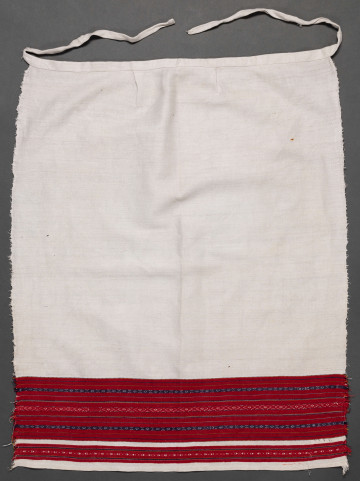
Pinafore
1910
National Museum in Lublin
Part of the collection: Folk craft of the Lublin Region (19th/20th c.)
The women's kaftan for the festive costume of Włodawa was sewn by hand by Władysława Łobacz. The museum bought it in Pogorzelec village, in Biała Podlaska poviat. It is made of dark-brown cloth, consists of two fronts, back and sleeves. The kaftan is short, fitted at the waist, slightly flared at the lower part. Triangular pockets are sewn onto the front below the waist. The neckline is rather deep and there is no collar. The fronts overlap and are fastened with five large hook-and-eye fasteners hooked into the so-called horsehair. The front, the sleeves at the base of the garment and the neckline are decorated with blue woollen twisted cord, are trimmed with yellow quilting and have in addition at the front small woollen pompoms in white, green and amaranth. The ornamentation consists of geometric and geometric floral motifs.
The cloth from which the kaftans were sewn was woven from carded woollen yarn in linen weave, dyed in the raw material. The fabric had to be subjected to a process of felting (spinning). This was done in the village looms, where a strip of fabric was first soaked in hot water, often with grey soap. Next, it was transferred to special tarns, where it was milled. This equipment was installed in water mills and was driven by a water wheel, usually a water wheel. The process took up to a few hours, and foiling was carried out throughout the year, depending on customer demand.
Author / creator
Dimensions
cały obiekt: height: 48 cm, width: 46 cm
Object type
kabat
Technique
sewing
Creation time / dating
Creation / finding place
Owner
The National Museum in Lublin
Identification number
Location / status

1910
National Museum in Lublin

1801 — 1900
National Museum in Lublin

1958
National Museum in Lublin
DISCOVER this TOPIC
National Museum in Szczecin
DISCOVER this PATH
Educational path